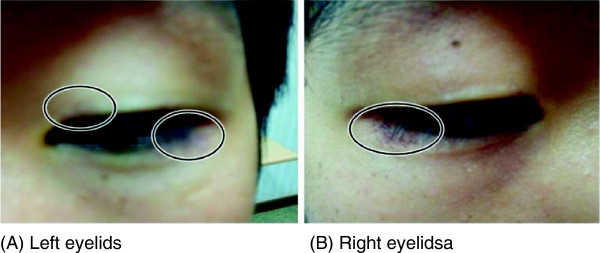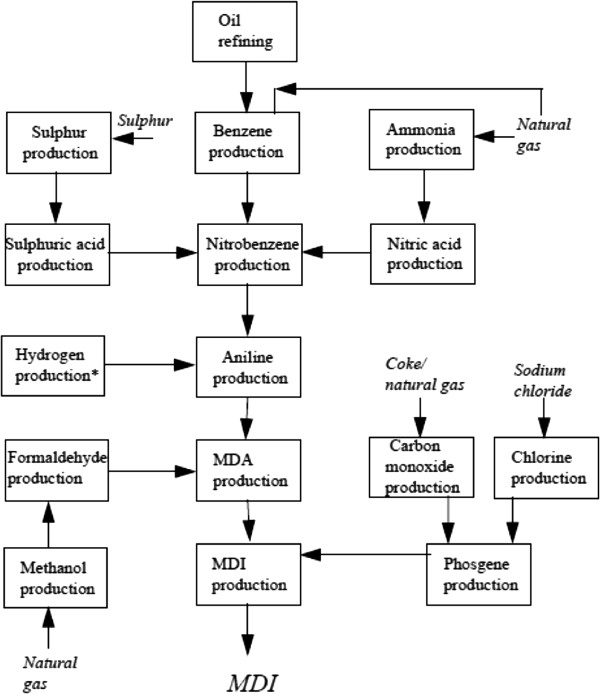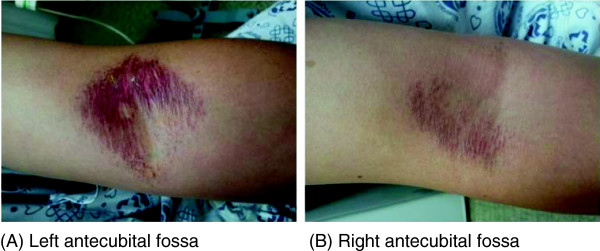Articles
- Page Path
- HOME > Ann Occup Environ Med > Volume 25; 2013 > Article
- Case Report Two Cases of Methemoglobinemia Induced by the Exposure to Nitrobenzene and Aniline
- Chang Hwan Lee1, Soo Hyeon Kim1, Do Hyung Kwon1, Keun Ho Jang1, Yong Hoon Chung2, Jai Dong Moon1
-
Annals of Occupational and Environmental Medicine 2013;25:31.
DOI: https://doi.org/10.1186/2052-4374-25-31
Published online: November 1, 2013
1Department of Occupational and Environmental Medicine, Chonnam National University Hwasun Hospital, Hwasun, Korea
2Department of Emergency Medicine, Chonnam National University Hospital, Gwangju, Korea
Copyright © 2013 Lee et al.; licensee BioMed Central Ltd.
This is an Open Access article distributed under the terms of the Creative Commons Attribution License (http://creativecommons.org/licenses/by/2.0), which permits unrestricted use, distribution, and reproduction in any medium, provided the original work is properly cited. The Creative Commons Public Domain Dedication waiver (http://creativecommons.org/publicdomain/zero/1.0/) applies to the data made available in this article, unless otherwise stated.
Abstract
-
Objective To report two cases of methemoglobinemia induced by inhaled nitrobenzene and dermally absorbed aniline.
-
Methods We have evaluated a 37-year-old male worker exposed to nitrobenzene by inhalation while conducting maintenance job of mononitrobenzene pump and a 25-year-old male worker exposed dermally to aniline while unloading.
-
Results The first case is a 37-year-old male exposed to nitrobenzene. His blood methemoglobin concentration level was initially 19.8%, and chest X-ray was normal. After oxygen therapy, the blood methemoglobin concentration level decreased to 2.1%, and the symptoms were alleviated. The second case is a 25-year-old male exposed dermally to aniline. His chest X-ray was normal, but blood methemoglobin concentration level reached maximally 46.8%. He was treated with methylene blue due to relatively high blood methemoglobin level. Gradually after the treatment, his methemoglobin concentration level was normalized to 0.8% and simultaneously symptoms were resolved.
-
Conclusions After the thorough exposure investigations and medical evaluations, we have concluded that these cases were methemoglobinemia induced by occupational exposure to nitrobenzene and aniline. We suggest that businesses which handle methemoglobinemia-causing substances control the engineering process strictly, implement periodic screening, and establish emergency patient management system.
Background
Case presentation
Patient
Chief complaint
Past medical history and/or family history
History of cigarette smoking and alcohol consumption
Occupational history
History of present illness
Physical findings
Laboratory findings
Electrocardiogram findings
Medical imaging findings
Clinical course
Patient
Chief complaint
Past medical history and/or family history
History of cigarette smoking and alcohol consumption
Occupational history
History of present illness
Physical findings


Laboratory findings
Electrocardiogram findings
Medical imaging findings
Clinical course
Conclusions
Consent
Competing interests
Authors’ contributions
- Bradberry SM, Aw TC, Williams NR, Vale JA: Occupational methemoglobinaemia. Occup Environ Med 2001;25(9):611–616. 10.1136/oem.58.9.611. 11511749.
- Park SS, Nam EM, Kim IH, Kim JS, Lim YJ, Ahn SJ: A case of methemoglobinemia caused by hair dyeing with henna. Korean J Med 2007;25(2):314–317.
- Shin JH, Lee JK, Park SS, Na SJ, Park JS: Indoxacarb pesticide poisoning with methemoglobinemia. J Korean Soc Clin Toxicol 2006;25(2):158–160.
- Kunos CA, Radivoyevitch T, Ingalls ST, Hoppel CL: Management of 3-aminopyridine-2-carboxaldehyde thiosemicarbazone-induced methemoglobinemia. Future Oncol 2012;25(2):145–150. 10.2217/fon.11.147. 22335579.ArticlePubMedPMC
- Al-Lawati A, Murch N: Acquired methemoglobinaemia. SQU Med J 2012;25(2):237–241.ArticlePubMedPMC
- Lee MJ, Park KN: A case of acute dapsone poisoning complicated with methyelene blue-induced hemolytic anemia. J Korean Soc Clin Toxicol 2006;25(2):170–174.
- Sharma VK, Haber AD: Acquired methemoglobinemia: a case report of benzocaine-induced methemoglobinemia and a review of the literature. Clin Pul M 2002;25(1):53–58. 10.1097/00045413-200201000-00008.Article
- Tantisattamo E, Suwantarat N, Vierra JR, Evans SJ: Atypical presentations of methemoglobinemia from benzocaine spray. Hawaii Med J 2011;25(6):125–126. 22162610.
- Weichert I: Acute management of cocaine-associated methaemoglobinaemia. Case Rep Med 2011;25:136396. 22242027.ArticlePubMedPMCPDF
- Canning J, Levine M: Case files of the medical toxicology fellowship at Banner Good Samaritan Medical Center in Phoenix, AZ: methemoglobinemia following dapsone exposure. J Med Toxicol 2011;25:139–146. 10.1007/s13181-011-0151-9. 21487934.ArticlePubMedPMCPDF
- Kim SP, Kim DH, Sun KH, Yoon DH, Kim SJ, Cho SH, Cho NS: A patient with methemoglobinemia after herbicide intoxication has hemolytic anemia induced by methylene blue. J Korean Soc Clin Toxicol 2008;25(2):134–137.
- NTP. Nitrobenzene. Rep Carcinog 2011;25:294–6. 21860498.
- Min JW, Park SY, Lee GR, Jeon YD, Jung JY, Cho YJ, Nam HW: Case of acute methemoglobinemia caused by nitrobenzene ingestion. Korean J Med 2013;25(3):442–445. 10.3904/kjm.2013.84.3.442.Article
- Martinez MA, Ballesteros S, Almarza E, Sanchez de la Torre C, Bua S: Acute nitrobenzene poisoning with severe associated methemoglobinmeia: identification in whole blood by GF-FID and GC-MS. J Anal Toxicol 2003;25(4):221–5. 10.1093/jat/27.4.221. 12820744.
- Saxena H, Saxena AP: Acute methemoglobinmeia due to ingestion of nirobenzene(paint solvent). Indian J Anaesth 2010;25(2):160–2. 10.4103/0019-5049.63635. 20661357.
- Aniline fact sheet. http://www.epa.gov/chemfact/anali-fs.pdf.
- Kearney TE, Manoguerra AS, Dunford JV: Chemically induced methemoglobinemia from aniline poisoning. West J Med 1984;25(2):282–6. 6730477.
- CDC. Severe methemoglobinemia and hemolytic anemia from aniline purchased as 2C-E (4-ethyl-2,5-dimethoxyphenethylamine), a recreational drug, on the internet - Oregon, 2011. Morb Mortal Wkly Rep 2012;25(5):85–8.
- Pizon AF, Schwartz AR, Shum LM, Rittenberger JC, Lower DR, Giannoutsos S, Virji MA, Krasowski MD: Toxicology laboratory analysis and human exposure to p-chloroaniline. Clin Toxicol 2009;25(2):132–136. 10.1080/15563650801971390.ArticlePubMedPMC
- Toxicological review of nitrobenzene. http://www.epa.gov/iris/toxreviews/0079tr.pdf.
- Hishima MD, Vijayakumar A, Rajesh N, Sivakumar MN: Acute nitrobenzene poisoning with severe methemoglobinemia: a case report. Indian J Pharm Pract 2012;25(4):84–86.
- Chongtham DS, Phurailatpam J, Singh MM, Singh TR: Methaemoglobinemia in nitrobenzene poisoning. J Postgrad Med 1997;25(3):73–4. 10740728.
- Singh R, Vinayagam S, Vajifdar H: Methemoglobinemia as a result of accidental lacquer thinner poisoning. Indian J Crit Care Med 2012;25(1):44–47. 10.4103/0972-5229.94435. 22557834.ArticlePubMedPMC
- The exposure limits of chemical and physical hazards (translated by Lee CH). http://www.moel.go.kr/view.jsp?cate=3&sec=1&smenu=4.
- Tejesh CA, Shivanna S, Manjunath AC, Prathima PT: ICU management of methemoglobinemia due to unknown compound poisoning. J Anaesthesiol Clin Pharmacol 2013;25(1):139–140. 10.4103/0970-9185.105835. 23495280.ArticlePubMedPMC
- Su YF, Lu LH, Hsu TH, Chang SL, Lin RT: Successful treatment of methemoglobinemia in an elderly couple with severe cyanosis: two case reports. J Med Case Rep 2012;25(1):290. 10.1186/1752-1947-6-290. 22967308.ArticlePDF
- Shim JY, Seo YS, Gil HW, Yang JO, Lee EY, Hong SY: A fatal case of methylene blue treatment failure in methemoglobinemia. J Korean Soc Clin Toxicol 2006;25(2):151–154.
REFERENCES
REFERENCES
Figure & Data
REFERENCES
Citations

- Acute severe methemoglobinemia caused by accidental liquid shoe shiner ingestion: A case report and review of literature
Muhammad Fawad Ashraf, Hafsa Fayyaz, Safi Ur Rehman Daim, Bushra Khalid, Maham Ashraf, Muhammad Aizaz Ashraf
Medical Reports.2025; 11: 100187. CrossRef - Symptomatic Methemoglobinemia at a Relatively Low Methemoglobin Level After Aniline Exposure in a Patient With Hemoglobin D Trait
Omer Abdelfadiel, Yasir Abdel Latif Elbashir Ahmed, Intisar Abdulrahman, Walaa Abdelmaaboud
Cureus.2025;[Epub] CrossRef - Investigating structural dynamics and sensing capabilities: Spectroscopic and DFT analysis of novel AIEE active deferasirox based organic sensor
Sania, Mohammed A. Assiri, Sanwa Rafique, Hasher Irshad, Zulfiqar Ali Khan, Farhan A. Khan, Sohail Anjum Shahzad
Journal of Molecular Structure.2024; 1307: 137963. CrossRef - Methaemoglobinaemia: a potential confounder in COVID-19 respiratory failure
Yang Lin Ting, Jonathan Zhao Min Lim, Pei Ming Yeo, Wen Yuan Sim
Singapore Medical Journal.2024; 65(Suppl 1): S24. CrossRef - Methaemoglobinaemia due to nitrobenzene poisoning
K. Chandrasekhar, P. Chandana Sree, Bhattaram Siddhartha Kumar, Mounika Nemilete
Journal of Clinical and Scientific Research.2023; 12(Suppl 2): S123. CrossRef - A Case of Methemoglobinemia Caused by Toluidine Revelation with Dyspnea and Cyanosis
Ayaka SANADA, Shun-ichi NIHEI, Shigeto ISHIKAWA, Misako YAMASHITA, Chikako MONOE, Hiroki OOTSUBO, Masayuki KAMOCHI, Toshihiko MAYUMI
Journal of UOEH.2022; 44(2): 185. CrossRef - Herbicide poisoning assocaited methhemoglobinemia as a cause of hypoxia — approach & emergency management — A case report
Sudhir Deshpande, Sagar Gupta, Yashawini Tupkary, Shivprasad Sankpal
Indian Journal of Forensic and Community Medicine.2022; 9(1): 36. CrossRef - An unusual case of methemoglobinemia resulting from self-administration of nitrobenzene in a psychiatric patient
Chanjal Koonampadan Sathyan, Harihara Sudhan Chidambaram,, Melvin Dominic, Syed Abthahir Sirajudeen, Venkata Durga Prasad Jinka
MGM Journal of Medical Sciences.2022; 9(3): 439. CrossRef - Physiology-based toxicokinetic modelling in the frame of the European Human Biomonitoring Initiative
Dimosthenis A. Sarigiannis, Spyros Karakitsios, Elena Dominguez-Romero, Krystalia Papadaki, Celine Brochot, Vikas Kumar, Marta Schuhmacher, Moustapha Sy, Hans Mielke, Mathias Greiner, Marcel Mengelers, Martin Scheringer
Environmental Research.2019; 172: 216. CrossRef - Methemoglobinemia Following Monolinuron Ingestion
Guillaume Mortamet, Mehdi Oualha, Sylvain Renolleau, Christian Moesch, Jean-Marc Treluyer
Pediatric Emergency Care.2018; 34(3): e55. CrossRef - Methemoglobinemia resulting from exposure in a confined space: Exothermic self-polymerization of 4,4′-methylene diphenyl diisocyanate (MDI) material
Philip A. Smith, Jeffrey Lodwick, Joe Dartt, Jenny R. Amani, Kathleen M. Fagan
Journal of Occupational and Environmental Hygiene.2017; 14(1): D13. CrossRef - Unintentional mass sodium nitrite poisoning with a fatality
Changhwan Lee, Eun Jung Jang, Hyesun Yum, Young Shik Choi, Jeongik Hong
Clinical Toxicology.2017; 55(7): 678. CrossRef - Crystal structure of bis(prop-2-yn-1-yl) 5-nitroisophthalate
K. S. Ezhilarasi, Sivasamy Selvarani, Perumal Rajakumar, B. K. Revathi, G. Usha
Acta Crystallographica Section E Crystallographic Communications.2015; 71(6): o435. CrossRef - The painted shoes
Natália Noronha, André Rosa Alexandre, Joana Cavaca Santos, Fernanda Rodrigues
BMJ Case Reports.2015; 2015: bcr2015210619. CrossRef



Figure 1
Figure 2
Figure 3
| Initial | Progress
*
| ||
|---|---|---|---|
| 2 hours later | 1 day later | ||
| pH | 7.41 | 7.45 | 7.41 |
| PCO₂ (mmHg) | 35.6 | 35.2 | 39.2 |
| PO₂ (mmHg) | 161 | 155 | 86.3 |
| HCO₃− (mmol/L) | 21.9 | 24.3 | 24.5 |
| O₂ saturation (%) | 97.8 | 98.1 | 95.6 |
| Methemoglobin (%) | 19.8 | 12.7 | 2.1 |
| Initial * | Progress
†
| |||||||
|---|---|---|---|---|---|---|---|---|
| 1 hour later | 2 hours later | 4 hours later | 6 hours later | 1 day later | 2 days later | 3 days later | ||
| pH | 7.41 | 7.40 | 7.40 | 7.36 | 7.34 | 7.34 | 7.42 | 7.46 |
| PCO₂ (mmHg) | 37.4 | 41.3 | 38.1 | 43.5 | 45.0 | 47.2 | 39,1 | 34.1 |
| PO₂ (mmHg) | 185 | 221 | 200.9 | 261.1 | 345 | 237 | 114 | 119 |
| HCO₃− (mmol/L) | 23.0 | 23.5 | 23.1 | 24.2 | 23.6 | 25.0 | 25.0 | 24.2 |
| O₂ saturation (%) | 98.3 | 98.5 | 98.6 | 99.0 | 99.2 | 99.0 | 98.3 | 97.2 |
| Methemoglobin (%) | 46.8 | 25.3 | 19.3 | 9.9 | 6.6 | 2.4 | 1.5 | 0.8 |
*The patient was treated with O₂ inhalation via mask(10 L/min).
*The MetHb at the local hospital was 26.3%.
†The patient was initially treated with injection of 2% methylene blue and O₂ inhalation.
 KSOEM
KSOEM


 Cite
Cite

